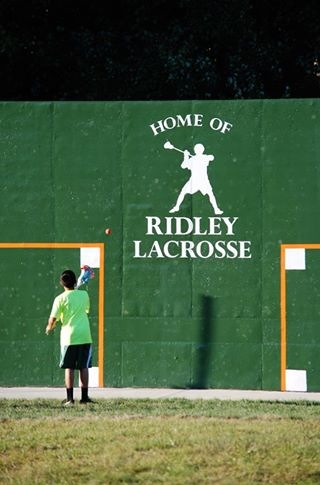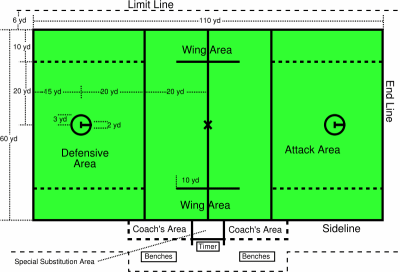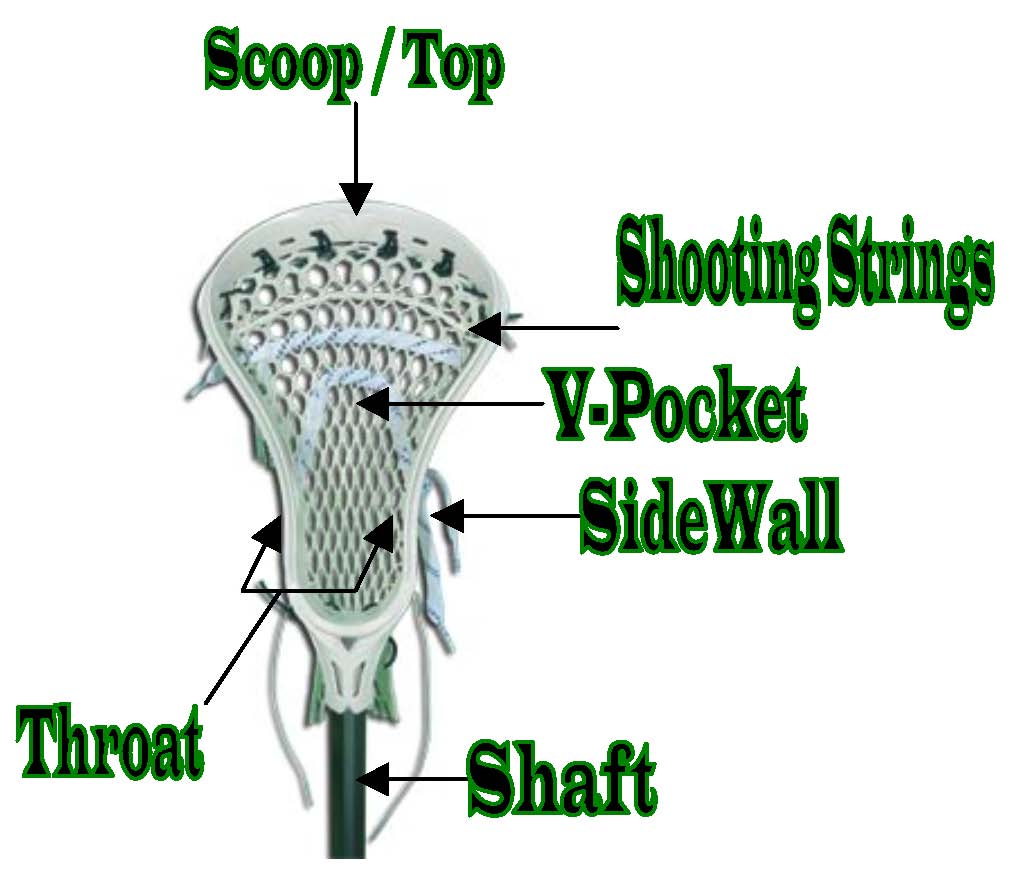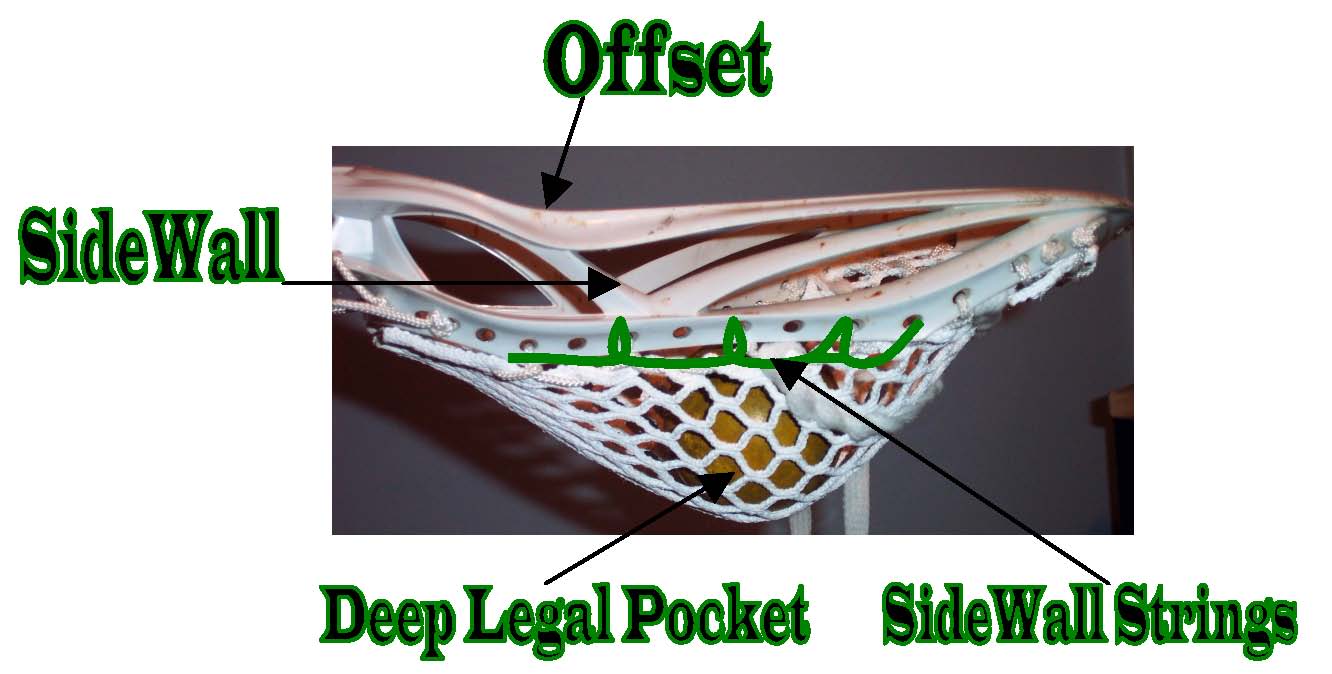News and Announcements
Here are some other Drills as well:
There are 5 Stages to this Drill, which you can do on your own. It always helps to have a shooting target/aid to help you with practicing your accuracy while throwing the ball against the wall. A piece of Athletic Tape is always a good idea, as you can remove it once you are done without leaving a mark.
MAKE SURE YOU ARE WEARING YOUR GLOVES WHEN YOU PRACTICE, IT WILL ONLY MAKE YOU BETTER.
Stand about 10 feet away from the wall - Stage 1
Stage 1: (this will help with general Catching and Throwing with both hands)
- Throw the ball Straight ahead about 50 times with your Strong hand, catching the ball with your Strong hand.
- Throw the ball Straight ahead about 25 times with your Weak (off) hand, catching the ball with your Weak (off) hand.
Stand about 10 feet away from the wall - Stage 2
Stage 2: A (this will help you to better Catch the Ball when it is thrown to opposite stick side for both hands, as most passes are not perfect) B (this will help you with switch hands when you have time to switch hands when ball is in the air to keep your stick away from your oppenent)
- Throw the ball Crossways about 10-25 times with your Strong hand, catching the ball on your Weak (off) hand side, but still using your Strong hand.
- Throw the ball Crossways about 10 times with your Weak (off) hand, catching the ball on your Strong hand side, but still using your Weak (off) hand.
- Throw the ball Crossways about 50-100 times with strong hand, while ball is in air hitting the wall SWITCH HANDS, and catch the ball with your weak hand. Now throw the ball Crossways with weak hand, while ball is in air hitting the wall SWITCH HANDS, and catch the ball with your strong hand. Repeat these steps while switch in hands while ball is in the air.
Stand about 15-20 feet away from the wall - Stage 3
Stage 3: (this will help you to have a quick reaction to passes and catching the ball, as the ball will land either by your feet, hip, and head, so that you can catch the ball wherever it maybe land when a pass comes to you)
- Throw the ball Straight about 50 times with your Strong hand, letting the ball hit the wall, then bounce on the ground, and up into your strong hand side.
- Throw the ball Straight about 10-25 times with your Weak (off) hand, letting the ball hit the wall, then bounce on the ground, and up into your Weak hand side.
- Remember to always be stepping to the ball as it comes to you. Just as if a pass is being throw to you.
Run along the wall about 10-15 feet away from the wall, a long wall is best to use for this. - Stage 4
Stage 4: (this will help you to Catch and Throw the ball while moving on the run)
- Throw the ball straight about 25-50 times with your Strong hand. Do this while running along the wall (find a wall that is 15-25 Yards) Throwing and Catching while running with your strong hand.
- Throw the ball straight about 10-25 times with your Weak (off) hand. Do this while running along the wall (find a wall that is 15-25 Yards) Throwing and Catching while running with your Weak (off) hand.
Stage 5: (this will help you with "over the shoulder" catches, When you are moving up field and your teammate is leading you with a pass so that you do not have to stop to catch the ball, this is very important for ALL players, but is even better for Defensemen and Middies to master, for clearing and fast breaks)
- Strong Hand - Throw the ball at the ground (about a few feet before the wall starts) so it bounces on the ground then have the ball bounce off the wall.(It will make the ball go in the air over you). Once ball bounces off the wall turn around and run away from the wall so you are catching the ball over your shoulder. (just like a wide reciever would do when catching a long pass that is leading him). Go back to wall and repeat for 25-50 times.
- Do the same over shoulder wall drill now with your weak hand and repeat for 10 times.
- If you are having trouble catching choke up on your stick by moving your top hand up towards where the plastic head meets the metal shaft of your stick (Just for catching the ball, you will have to move your hand down after catching so you are ready to throw the ball). In time you will be able to get better and move your top hand down to a normal catching hand postion on your stick, about the same hand position as you do when throwing the ball.
Practice all of these Wall Ball Stages once a day, and you will see a big improvement with your overall stick skills. Once you get really good at them add the advanced wall ball drill (below) to your daily wall ball routine. Also make up some of your own drills to add to your routine.
***Helpful Hint: it is not a bad idea to use music (ipod/mp3 player with your own playlist) while doing your wall ball drills, just run your headphone wires down your back under your shirt. Having music can sometimes help motivate you and keep you on the wall longer, just like any work out routine ***
ADVANCED WALL BALL DRILL
This Drill is to be used with and after you have completed the first wall ball drill and can do the first one with ease.
Stand Close to wall 5-10 feet away
- Quick stick - 50 times right, 50 times left (NO cradle)
- One handed quick stick - 25 right, 25 left (NO cradle)
- Quick stick change of hands - 25 right, 25 left - switch hands while ball is in the air (NO Cradle, or half Cradle if needed)
Step a few feet further away
- Fast Catch and cradle - 50 right, 50 left (ONE Cradle ONLY and throw) This should be Fast throwing and catching, with only 1 cradle after catching.
- Face dodge - 50 right, 50 left (catch Ball-face dodge switching hands-throw)
- Roll dodge - 50 right, 50 left (catch Ball-roll dodge, protect, change hands-throw) cross handed - 50 right/50left
- Split dodge - 50 right, 50 left (catch Ball- split dodge and throw) (change hands if you fake and go opposite way on you split dodge.)
Key words in explaining proper throwing form:
- Hands up and out from your body (hands should not be close to your body, you loose power/accuracy that way), your bottom hand elbow up pointing at target.
- Point stick like a bazooka (stick almost on the shoulder) your butt-end is point at target same with your bottom hand elbow.
- Push-Pull or sometimes called Pull-Punch motion. Pull is (bottom hand) and push/punch is (top hand)
- Point your toe towards target
- Follow through with your hands, arms, hips, and body.

- It is very important to buy a stick that fits your skill level. New players should consider a head with a wider throat area which makes it easier to learn the art of catching the lacrosse ball. Most performance heads will be narrower at the base of the head and form a channel to guide the ball for accuracy but this makes catching the ball more difficult. Performance heads are used by older and more advanced players.
- Stick Length - Men's attack/midfield sticks run between 40-42 inches in length whereas men's defense sticks usually are between 52-72 inches in length. Measurement is from the Top (scoop) end to the end of the shaft (butt-end). An attack/midfield sticks can measure no shorter than 40” inches to be legal. Some 4th grade and younger leagues allow players to have a shorter stick. Be sure to ask your coach if it is allowed.
- Stick Weight - Lighter heads and shafts add maneuverability and allow you to generate more speed on your shot. This is especially important for players in attack positions. Heavier, thicker shafts increase the strength of your stick which is often preferred by defensive players.
- The softer the mesh in the lacrosse head, the more forgiving it is, thus making it easier to catch the ball. Stiff mesh or dura-mesh provides more power on your shots and passes.
- Lower side rails allow for a deeper Pocket, which helps you maintain control of the ball, while being checked. A shallow Pocket allows for a quicker release for pass or shot, but does not offer that much ball control. Beginners should use somewhat of a deep pocket until they are more experienced to know what kind of a Pocket they prefer.

- Attack Goal Area: The area defined by a line drawn sideline to sideline 20 yards from the face of the goal. Once the offensive team crosses the midfield line, it has ten seconds to move the ball into its attack goal area.
- Body Check: Contact with an opponent from the front - between the shoulders and waist - when the opponent has the ball or is within five yards of a loose ball.
- Box: An area used to hold players who have been served with penalties, and through which substitutions ""on the fly"" are permitted directly from the sideline onto the field.
- Check-up: A call given by the goalie to tell each defender to find his man and call out his number.
- Clamp: A face-off maneuver executed by quickly pushing the back of the stick on top of the ball.
- Clearing: Running or passing the ball from the defensive half of the field to the attack goal area.
- Crease: A circle around the goal with a radius of nine feet into which only defensive players may enter.
- Defensive Clearing Area: The area defined by a line drawn sideline to sideline 20 yards from the face of the goal. Once the defensive team gains possession of the ball in this area, it has ten seconds to move the ball across the midfield line.
- Extra man Offense (EMO): A man advantage that results from a time-serving penalty.
- Face-Off: A technique used to put the ball in play at the start of each quarter, or after a goal is scored. The players squat down and the ball is placed between their crosses.
- Fast-Break: A transition scoring opportunity in which the offense has at least a one-man advantage.
- Free Lance: A style of play on offense when no play or set offense is being used. Offensive players move freely by cutting and feeding for an opportunity to score.
- Ground Ball: A loose ball on the playing field.
- Handle (Shaft): An aluminum, wooden or composite pole connected to the head of the crosse.
- Head: The plastic or wood part of the stick connected to the handle.
- Man Down Defense (MDD): The situation that results from a time-serving penalty which causes the defense to play with at least a one man disadvantage.
- Midfield Line: The line which bisects the field of play.
- On-The-Fly Substitution: A substitution made during play.
- Pick: An offensive maneuver in which a stationary player attempts to block the path of a defender guarding another offensive player.
- Rake: A face-off move in which a player sweeps the ball to the side.
- Riding: The act of trying to prevent a team from clearing the ball.
- Release: The term used by an official to notify a penalized player in the box that he may re-enter the game.
- Unsettled Situation: Any situation in which the defense is not positioned correctly, usually due to a loose ball or broken clear.

- Offset (n) - angle at which the front of the head is curved if viewing it from the side; a full-offset head maximizes control and feel whereas non-offset (no curve) or mid-offset heads are recommended for beginners for learning how to throw properly.
- Scoop (n) - the top part of the lacrosse head used to "scoop" up the ball.
- Throat (n) - the width between the lower curved part of the head, where the ball pass through to catch the ball in the stick.
- Pocket (n) - the stringing or mesh in the head of the stick that catches, holds and directs the ball when passing or shooting.
- Legal Pocket (n) - The entire Circle of the ball cannot be seen in the pocket from a side view of the head. If the entire ball can be seen then the pocket is Illegal.
- Shooting Strings (n) - The strings towards the top of the head, usually Hockey Lace or Nylon strings are used. Helps controls the ball release and whip out of the stick when throwing.
- V-Pocket (n) - A V-Shape String located right in the middle of the head around the pocket, usually Hockey Lace. Helps keep the ball in your pocket for more ball control when cradling.
- Sidewall Strings (n) - Nylon strings on both sides of the head that run along the bottom rail of the Sidewall. These strings determine the depth of your pocket.
- Sidewall (n) - either side of a lacrosse stick head.
- Whip (n) - the amount of downward direction in the balls path coming out of the stick onan overhead shot or pass as a result of contact with the shooting strings.


- Catching: The act of receiving a passed ball with the Stick.
- Checking: The act of attempting to dislodge the ball from an opponent's stick.
- Poke Check: A stick check in which the player pokes the head of his stick at an opponent's stick through the top hand by pushing with the bottom hand.
- Slap Check: A stick check in which a player slaps the head of his stick against his opponent's stick.
- Wrap Check: A one-handed check in which the defender swings his stick around his opponent's body to dislodge the ball. (This check is only legal at the highest level of play.)
- Cradling: The coordinated motion of the arms and wrists that keeps the ball secure in the pocket and ready to be passed or shot when running.
- Cutting: A movement by an offensive player without the ball, toward the opponent's goal, in anticipation of a feed and shot.
- Feeding: Passing the ball to a teammate who is in position for a shot on goal.
- Passing: The act of throwing the ball to a teammate with the stick.
- Scooping: The act of picking up a loose ball with the stick.
- Screening: An offensive tactic in which a player near the crease positions himself so as to block the goalkeeper's view of the ball.
- Shooting: The act of throwing the ball with the stick toward the goal in an attempt to score.